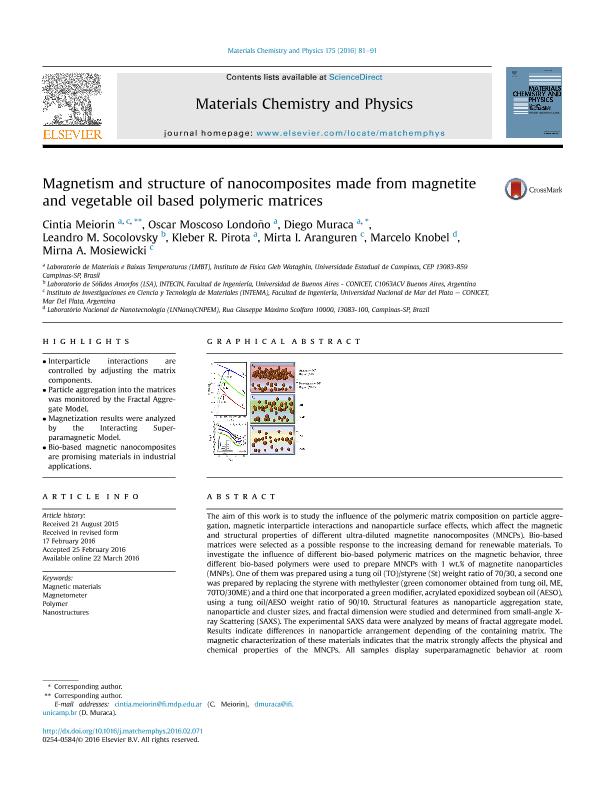Artículo
Magnetism and structure of nanocomposites made from magnetite and vegetable oil based polymeric matrices.
Meiorin, Cintia ; Moscoso Londoño, Oscar
; Moscoso Londoño, Oscar ; Muraca, Diego
; Muraca, Diego ; Socolovsky, Leandro Martín
; Socolovsky, Leandro Martín ; Pirota, Kleber R.; Aranguren, Mirta Ines
; Pirota, Kleber R.; Aranguren, Mirta Ines ; Knobel, Marcelo; Mosiewicki, Mirna Alejandra
; Knobel, Marcelo; Mosiewicki, Mirna Alejandra
 ; Moscoso Londoño, Oscar
; Moscoso Londoño, Oscar ; Muraca, Diego
; Muraca, Diego ; Socolovsky, Leandro Martín
; Socolovsky, Leandro Martín ; Pirota, Kleber R.; Aranguren, Mirta Ines
; Pirota, Kleber R.; Aranguren, Mirta Ines ; Knobel, Marcelo; Mosiewicki, Mirna Alejandra
; Knobel, Marcelo; Mosiewicki, Mirna Alejandra
Fecha de publicación:
02/2016
Editorial:
Elsevier Science Sa
Revista:
Materials Chemistry and Physics
ISSN:
0254-0584
Idioma:
Inglés
Tipo de recurso:
Artículo publicado
Clasificación temática:
Resumen
The aim of this work is to study the influence of the polymeric matrix composition on particle aggregation, magnetic interparticle interactions and nanoparticle surface effects, which affect the magnetic and structural properties of different ultra-diluted magnetite nanocomposites (MNCPs). Bio-based matrices were selected as a possible response to the increasing demand for renewable materials. To investigate the influence of different bio-based polymeric matrices on the magnetic behavior, three different bio-based polymers were used to prepare MNCPs with 1 wt.% of magnetite nanoparticles (MNPs). One of them was prepared using a tung oil (TO)/styrene (St) weight ratio of 70/30, a second one was prepared by replacing the styrene with methylester (green comonomer obtained from tung oil, ME, 70TO/30ME) and a third one that incorporated a green modifier, acrylated epoxidized soybean oil (AESO), using a tung oil/AESO weight ratio of 90/10. Structural features as nanoparticle aggregation state, nanoparticle and cluster sizes, and fractal dimension were studied and determined from small-angle X-ray Scattering (SAXS). The experimental SAXS data were analyzed by means of fractal aggregate model. Results indicate differences in nanoparticle arrangement depending of the containing matrix. The magnetic characterization of these materials indicates that the matrix strongly affects the physical and chemical properties of the MNCPs. All samples display superparamagnetic behavior at room temperature, but the blocking temperature varies from 75 K (tung oil/styrene with 1 wt.% MNPs) to 126 K (tung oil/AESO 1 wt.% MNPs). Furthermore, the temperature dependence of the coercive field changes for all samples, suggesting a strong influence of the polymer properties on the magnetic properties of the MNCPs.
Archivos asociados
Licencia
Identificadores
Colecciones
Articulos(INTEMA)
Articulos de INST.DE INV.EN CIENCIA Y TECNOL.MATERIALES (I)
Articulos de INST.DE INV.EN CIENCIA Y TECNOL.MATERIALES (I)
Citación
Meiorin, Cintia; Moscoso Londoño, Oscar; Muraca, Diego; Socolovsky, Leandro Martín; Pirota, Kleber R.; et al.; Magnetism and structure of nanocomposites made from magnetite and vegetable oil based polymeric matrices.; Elsevier Science Sa; Materials Chemistry and Physics; 175; 2-2016; 81-91
Compartir
Altmétricas



